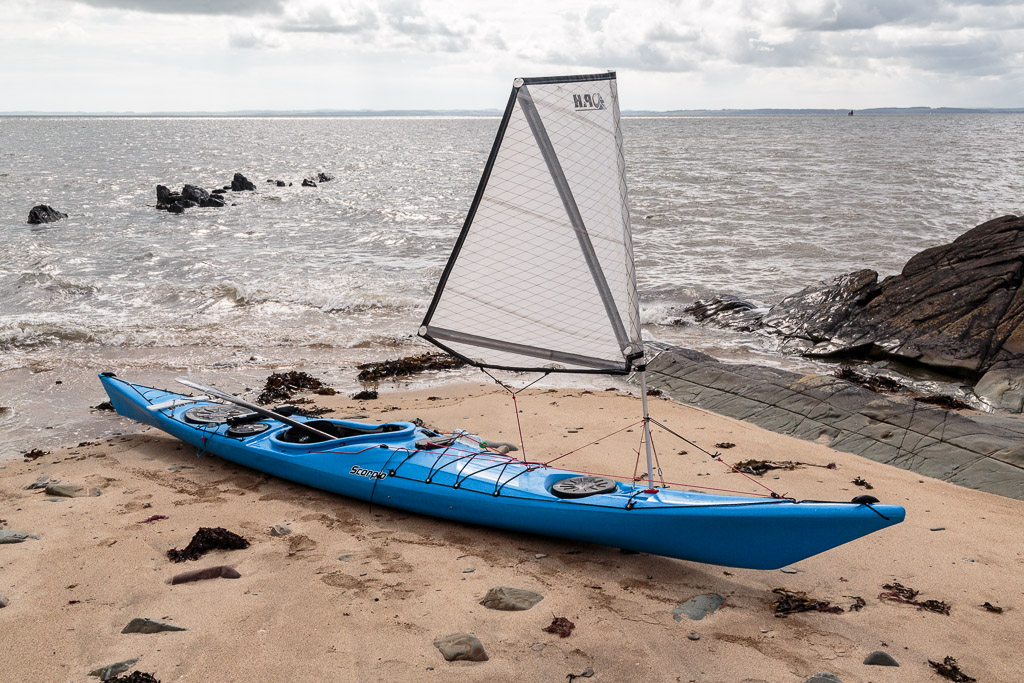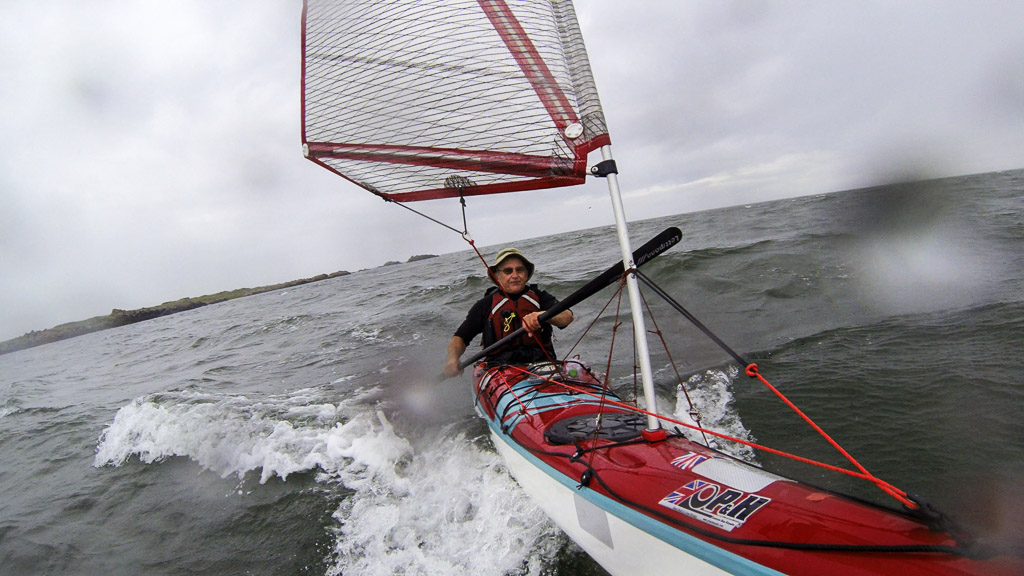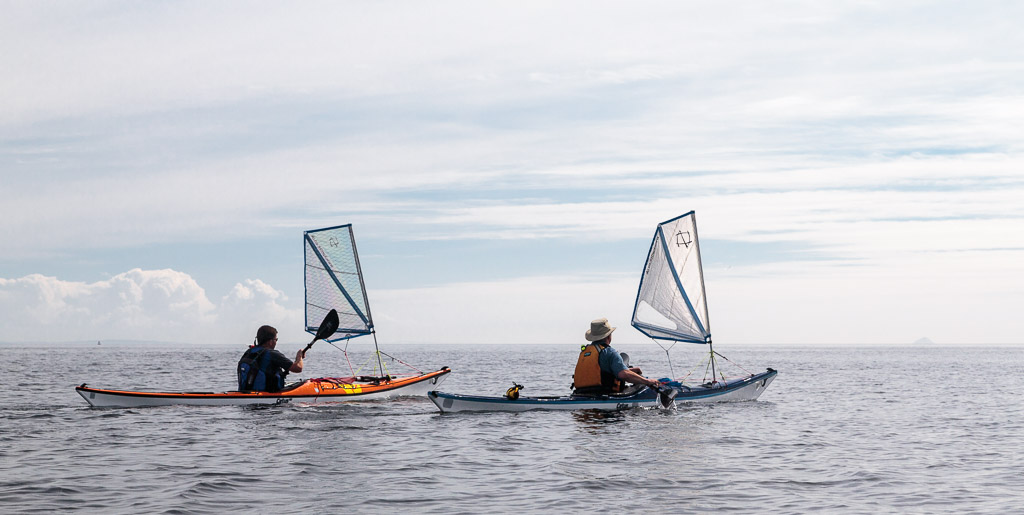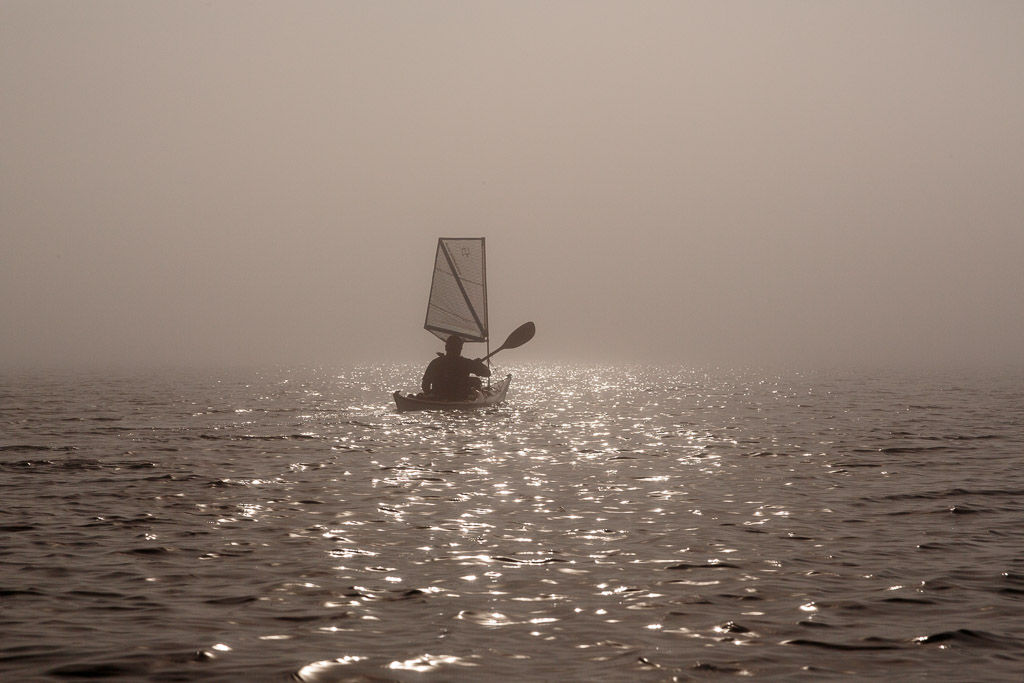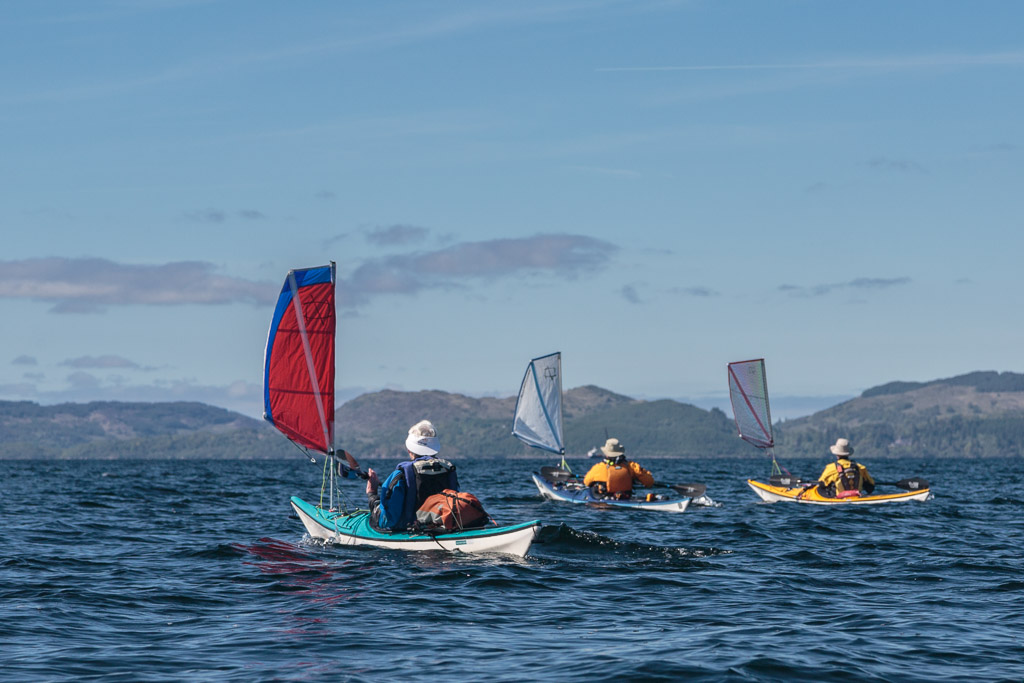About the test:
paddling conditions and paddlers.
This test is based on testing the P&H Scorpio MK2 MV over 4 months in the summer and autumn of 2015.
The test took place in open and sheltered waters on the west coast of Scotland:
the west coast of Kintyre, Gigha and Cara, the Sound of Jura, the North
Channel, the Firth of Clyde and the Solway Firth. It involved open crossings of
up to 14km, waters with strong tides in the Solway, Kintyre and the Sound of Jura
and major headlands and tide races such as at the Mull of Galloway and Crammag
Head. It has been used extensively in wind against tide conditions during a
very windy July and August on the Solway . The test involved 27 day trips and a
further 8 day/night camping trips to islands in the Hebrides, Firth of Clyde
and the Solway Firth. The main tester was 1.73m tall, weighed 85kg and paddled
the Scorpio Mk2 MV for about 700km. It was paddled by seven other people who ranged
in weight from 55 to 105kg and 164 to 184cm in height. Their experience ranged
from beginner to 5* level. During the test period the kayak was a free loan
from P&H but in case you think this might introduce a degree of bias, the
main tester has also had free loans of kayaks from several other manufacturers
whose kayaks are available in the UK. During the period of the test the Scorpio Mk2 MV was paddled back to back with a Scorpio 170 and three P&H Cetus MV
kayaks.
Design.
Scorpio Mk2 MV with Cetus MV behind.
The Scorpio Mk2 MV is a development of the successful Scorpio 170, which was itself modelled on the Cetus composite range. In size The Scorpio Mk2 MV is longer and wider than the old Scorpio 170 and shorter and wider than the Cetus MV. Its volume is midway between these other kayaks. However, on the beach it looks very similar to the Cetus MV. Its wide point is just behind the cockpit. It has moderate tail rocker and quite marked bow rocker. Under hull it has a shallow V from the keel line running into softly rounded chines. The Scorpio Mk2 MV is 525cm long and 58cm wide. It is 317l in volume. Apart from being longer and wider than the original Scorpio 170, the Scorpio Mk2 MV has a lowered rear deck and cockpit rim and the lips of the hatch rims have been modified to allow easier fitting of the covers. The foredeck has been modified with inserts for attaching a sailing rig mast foot and mouldings for split paddle handles lie on either side of the compass recess. These mouldings make the foredeck very stiff and unlike many PE kayaks it requires no further reinforcement for the fitting of a mast foot. The line of the deck from the side of the cockpit to the mast foot has been modified to allow the stowed sailing rig to lie neatly. Two of the deck lines' recessed deck fittings (RDFs) have been moved to allow fitting mast side stays at right angles to the mast. The skeg/skudder control has been moved from the side of the fore deck to the top.
Construction, finish, fittings and ergonomics.
Unwrapping the Scorpio Mk2 MV was a treat. It is a beautifully proportioned sleek kayak despite its maximum breadth and the attention to detail is superb e.g. the embossed P&H logo on the alloy security bar. The boat is constructed from three layer CoreLite polyethylene. It is stiff for a PE boat and at 28.7 kg is remarkably only 0.5kg heavier than a diolen composite Cetus MV in expedition layup with a keel strip. New for 2016, the roto-molded Scorpio Mk2 will be available in CoreLite X which will be even lighter and stiffer. The bulkheads are of 7.5cm thick black foam. This has considerably reduced the volume of the rear day hatch which is 15cm shorter compared with that in the composite Cetus MV. The test boat was supplied in a stunning marbled "Ikea" blue (it matched my bags!) The moulding was particularly well finished with some matt and glossy areas. Large glossy P&H logos appear on the fore deck and the under hull. Rather disappointingly either side of the hull at the bow is finished in matt. This means that you cannot mount a suction cup for a remote camera on an extension rod. (if you don't have a sail then the flat mast base area would be a good alternative camera mounting point.) There is an alloy security bar behind the cockpit which I use for attaching a tow line using a water ski quick release shackle.
On the foredeck there is a forward mini hatch. Its cover
is very easy to remove and fit but like many other PE kayaks the mini hatch is
not waterproof. The round fore hatch and oval rear hatch have rubber KayakSport
covers and are indeed much easier to fit than on previous P&H PE kayaks
like my Delphin. The rear day hatch is a lightweight model with a plastic
centre and was very easy to open and close when on the water. As mentioned above, the rear day hatch is considerably smaller than the equivalent hatch in the Cetus MV due to the fact that the two foam bulkheads are a total of 15cm thick. If volume is important to you on expedition it might be worth considering the Scorpio Mk2 HV which will be released in mid 2016. The hatch
recesses have moulded drainage channels. In normal use and during rolling
sessions the three main hatches remained bone dry. The boat had the usual
excellent P&H deck elastic and deck line arrangement. I particularly like
the fact that the rear deck lines come right up to the rear of the cockpit.
This allows the paddle to be secured during a paddle float re-entry.
The Scorpio Mk2 MV comes either the MK2 P&H skeg or the Skudder. I have found the MK2 skeg
to work faultlessly on other kayaks, as long sand is washed out of the skeg box
and the tension in the downhaul elastic is regularly checked.
The skeg (and
skudder) adjustment slider has been moved from the left side of the onto the
top of the deck to the left of the midline. This is a great move as it stops
your paddle hand catching and releasing it (especially if you are wearing
pogies). Even walking past a boat with the slider mechanism in the original
position can brush against and release the skeg which is not good if you are about
to push it back into the water. The new position is out of the way and easy to
get to. I use a large deck bag for a DSLR camera. I needed to fit it slightly
forward to clear the skeg adjuster but I could still reach it easily. The only
disadvantage of the new position is that it is a sand trap if you are launching
in dumping surf on a sand beach. So keep an eye on this and wash any sand out
without delay.
The cockpit is 80cm long which means I found it easy to get in
and out, even with bad knees. The cockpit rim has been modified and I found a
Reed spray dick fitted securely and had no tendency to come off in dumping
surf. The deck round the cockpit is also very stiff and flexes very little when
bracing your legs in the comfortable, adjustable thigh braces. Tools are
required to adjust the thigh braces but it is a straightforward job. The seat
is the P&H Connect seat with padded cover and adjustable backrest and hip
pads. It is fitted nice and low in the cockpit. I found it easy to get a very
comfortable fit in the Scorpio Mk2 MV as did most of the testers. The largest tester
did find his feet (UK size 12, 89cm inside leg) cramped but I had no trouble
with my size 10 Lomo boots with 74cm inside leg. The 55kg paddler enjoyed the
Scorpio Mk2 MV but is considering buying the Scorpio Mk2 LV which is a more appropriate
size.
The test boat was fitted with the optional Skudder, a
combined rudder and skeg mounted in the usual skeg position. It has a decent
sized blade to aid control. It is also considerably stiffer than the standard
P&H skeg.
All the control cables are contained within the boat and the rear
control levers over the rudder are covered by a flush plastic cover on the rear
deck. The rear hatch looses a little room compared with a simple skeg box but
long thin items can still go up either side. The Skudder is incredibly well
designed and engineered especially given the price of the boat it is fitted to.
It is controlled by Smart Track foot pedals, which self adjust as the footrests
are slid back and forwards. It did not need any adjustment during the test.
In use it acts as a skeg if you deploy it up to just over half way. If you put
it fully down the pedals can now turn it and it acts like a rudder. It does not
self centre as you put it away so you need to centre it with your feet first.
Until you get used to this, do not leave it till the last minute before
landing.
The only downside is that the pivot pin for the Skudder is in an
exposed position at the front of the skeg box. The hinge is unaffected by
shingle, mud, or fine sand but some coarse shell sands (as found on the Outer
Solway) can jam it and If the boat has been sitting on such sand you should
make sure it is clear after launching but before getting into the boat. Some rental companies using Venture kayaks with the Skudder have experienced problems with the vertical rod which turns the rudder. At the end of the test I dismantled the Skudder but found no problems. Either the design/construction has changed or rental kayaks get much more wear than the 700km I covered and the 300km others covered in this Scorpio kayak.
The test kayak came with the P&H Code Zero sailing rig.
The mast, stays and mast foot are supplied by Kari-Tek. The sail is made by
Flat Earth in Australia and uses a very similar cut to their own Trade Wind
sail. The P&H sail was tested in OP #46. Since then, P&H have changed
to a four stay design from Kari-Tek's three stay system. Three mini karabiners
are supplied for the side and back stays so that once you have their length
adjusted, you can quickly remove and fit the sail without need for further
adjustment. As mentioned above, two of the RDF's have been moved so that they
are at right angles to the mast foot, which is the ideal position for attaching
the two side stays.
The two cleats for the uphaul/forestay and the sheet have
fairleads. I prefer cleats without fairleads so that the lines can be released
instantly (without fear of re-jamming) in the event of a sudden squall or
capsize. The sail has a shorter luff than previous Flat Earth sails and on the
standard mast you can see forward under it so no window is required in the
sail.
Overall performance.
I felt comfortable in the Scorpio Mk2 MV straight away. I have been sea
kayaking as often as I can for 13 years and when I first saw how beamy the Scorpio Mk2 MV was, I wondered whether I would find it boring to paddle. I also
thought if it would feel more uncontrollable in really rough conditions than a
boat like my Nordkapp LV, which is narrow with highly rocked, low volume ends.
Surprisingly the Scorpio Mk2 MV is remarkably unflappable in the rough stuff.
Photo from the Scorpio MK2 MV off Garroch Head.
I was
taking photographs with my DSLR in F4/5 wind over a spring tide in the Garroch
Head tide race in conditions I would not have dared to take the camera out in
the Nordkapp LV.
The Scorpio Mk2 MV off Garroch Head Photo by Ian Johnston
I think that some advanced paddlers may be surprised by the
Scorpio Mk2 MV's abilities. It would make a great, robust kayak for guiding or
coaching. Not once during my time with the Scorpio Mk2 MV did I feel that I would
rather be in one of my other kayaks. I now wonder whether a composite kayak with
a similar maximum beam but the overall slim lines of the Scorpio Mk2 MV shape might
be a success? Whatever, I think P&H have hit a sweet spot with this design.
Stability and rolling
The Scorpio Mk2 MV is remarkably stable for a touring sea kayak due both to its width and rear set wide point. It is an ideal platform for coaching, photography, bird watching or fishing. It is incredibly stable when on edge and is great fun when weaving through rock gardens. It rolls very smoothly but a little more slowly than the narrower Cetus MV. The lowered rear cockpit edge makes back deck rolling much more comfortable than the old Scorpio, without having to raise your backside off the seat.
The Scorpio Mk2 MV is remarkably stable for a touring sea kayak due both to its width and rear set wide point. It is an ideal platform for coaching, photography, bird watching or fishing. It is incredibly stable when on edge and is great fun when weaving through rock gardens. It rolls very smoothly but a little more slowly than the narrower Cetus MV. The lowered rear cockpit edge makes back deck rolling much more comfortable than the old Scorpio, without having to raise your backside off the seat.
Speed, manoeuvrability
and tracking
The Scorpio Mk2 MV is easily able to maintain a normal all day touring pace of 6-7.5km/hour whether loaded or unloaded. Despite paddling regularly with three other paddlers in Cetus MVs at no time did I feel disadvantaged, even after a day where we covered 47km. The glide and tracking are both improved over the old Scorpio 170. Despite being more directional when paddling a course than its elder sibling it was noticeably faster to turn on edge. I found my maximum burst speed was about 10% down compared with the Cetus MV in the same conditions. When paddle sailing in waves in a good F4/5 day my top speed in the Scorpio Mk2 MV was 18km/hour on the best wave and 20.5km/hr in the Cetus MV on its best wave. A little skeg helps with tracking as the wind picks up but the adjustment range on the slider (when in skeg mode) is shorter than on a conventional skeg and so it is a bit more tricky to get just the right amount of skeg.
The Scorpio Mk2 MV is easily able to maintain a normal all day touring pace of 6-7.5km/hour whether loaded or unloaded. Despite paddling regularly with three other paddlers in Cetus MVs at no time did I feel disadvantaged, even after a day where we covered 47km. The glide and tracking are both improved over the old Scorpio 170. Despite being more directional when paddling a course than its elder sibling it was noticeably faster to turn on edge. I found my maximum burst speed was about 10% down compared with the Cetus MV in the same conditions. When paddle sailing in waves in a good F4/5 day my top speed in the Scorpio Mk2 MV was 18km/hour on the best wave and 20.5km/hr in the Cetus MV on its best wave. A little skeg helps with tracking as the wind picks up but the adjustment range on the slider (when in skeg mode) is shorter than on a conventional skeg and so it is a bit more tricky to get just the right amount of skeg.
The Skudder
I was not expecting a great deal from the Skudder in rudder mode. I was wrong
and as the months on test went by, I found I was using the rudder mode more and
more, even without the sail! It is not a panacea for manoeuvring a kayak but
unlike some systems I have tried, it does have a big enough blade to be
effective, even when paddling at 45 degrees to the wind (when some rudder
systems are better lifted as they cause lee cocking if you cannot paddle fast
enough). The 5* paddler felt there was no need for the rudder as the Scorpio Mk2 MV
was so manoeuvrable when edged. Initially I agreed but then I discovered that
the Skudder works remarkably well for more advanced paddlers when used with
edging and steering strokes. Then I noticed that two of the early intermediate
paddlers had started to automatically edge the kayak when they were using the
Skudder! The beginners loved it.
See here for a detailed review of the Skudder.
Behaviour in wind and
waves
Due to its sleek low profile and rocker line the Scorpio Mk2 MV is very well
behaved in wind. It gently weathercocks but this is easily controlled by the
Skudder in either skeg or rudder mode. The low profile means that in choppy
conditions when paddling to windward the Scorpio Mk2 MV is quite a wet kayak.
However, it is dry when paddling downwind and the tail rocker is very good at
picking up following seas. Once on a wave the bow rocker keeps the bow clear of
the water if you get the kayak planing. If you stuff it down into the trough
then the bow rocker helps prevent purling (nose diving). Like other kayaks with
a rear set wide point the Scorpio Mk2 MV is surprisingly manoeuvrable if you stay
high on the wave. This can lead to a sudden broach but more advanced paddlers
will be able to use this manoeuvrability to correct early and run straight.
Paddling when
loaded
The Scorpio Mk2 MV is a bit more directional when
loaded with camping gear and if anything the Skudder in rudder mode is even
more useful on such a trip. Although the wide point of the kayak is aft of the
cockpit, the rear deck is low so the rear hatches do not have so much volume as
some kayaks of similar length and overall volume. As a result it is easy to put
too much weight in the front. It is important to distribute the weight about
60% in the rear and 40% at the front otherwise the kayak will develop excessive
weather cocking. If you get the balance right the loaded Scorpio Mk2 MV is
delightfully neutral to paddle whatever the wind or wave conditions.
Paddle sailing.
The Scorpio Mk2 MV is a great boat for paddle sailing, especially if you are
new to using a sail or don't like drilling holes in a new boat. (You still need
to decide where to mount the two cleats but as they screw into the cockpit area
you won't be worried about creating a leak.) Neither do you need to worry about
where to mount the mast foot as P&H have already found the best position.
Even beginners to kayaking were happy to deploy the sail in sheltered
conditions. Newcomers to paddle sailing need to realise that you don't just sit
there letting the sail do the work. You will soon get cold.
It is much more fun to paddle hard and use the sail for extra speed, especially downwind when you can catch faster waves than when using paddle power alone. More advanced paddle sailors will find the stability of the Scorpio Mk2 MV very reassuring as they push their paddle sailing into stronger wind and wave conditions. When travelling fast downwind, you need to be light footed with the Skudder. It is easy to steer too far one way then overcorrect the other. When paddle sailing downwind on an 11km crossing in F4 conditions with two paddle sailors in Cetus MVs, I found I was actually faster using the Skudder in skeg mode than rudder mode. In F4 winds the Skudder is big and effective enough to tack the Scorpio Mk2 MV through the wind. Most other over stern ruddered kayaks I have used for paddle sailing in such winds are easier to tack if you lift the rudder first.
It is much more fun to paddle hard and use the sail for extra speed, especially downwind when you can catch faster waves than when using paddle power alone. More advanced paddle sailors will find the stability of the Scorpio Mk2 MV very reassuring as they push their paddle sailing into stronger wind and wave conditions. When travelling fast downwind, you need to be light footed with the Skudder. It is easy to steer too far one way then overcorrect the other. When paddle sailing downwind on an 11km crossing in F4 conditions with two paddle sailors in Cetus MVs, I found I was actually faster using the Skudder in skeg mode than rudder mode. In F4 winds the Skudder is big and effective enough to tack the Scorpio Mk2 MV through the wind. Most other over stern ruddered kayaks I have used for paddle sailing in such winds are easier to tack if you lift the rudder first.
Conclusions
As the sun went down on my last night camping from the Scorpio Mk2 MV I reflected on what a great kayak I had enjoyed.
As the sun went down on my last night camping from the Scorpio Mk2 MV I reflected on what a great kayak I had enjoyed.
The Scorpio Mk2 MV is such a versatile kayak that if it had been available when
I started sea kayaking 13 years ago I would probably still have it. Over the 4 months of the test (during one of the windiest summer and autumns in 20 years) I really
grew to appreciate its versatility and forgiving nature. The various features
of the Scorpio Mk2 MV with Skudder and sail are so complimentary that the whole is
truly greater than the sum of its parts. Not only is this an ideal kayak for
those starting off in sea kayaking but it will grow with them and support the
development of advanced skills. It would also make a great kayak for coaching. Lastly,
the Scorpio Mk2 MV with Skudder and sail must be the easiest way into paddle
sailing. The only thing I can find wrong with it is that P&H wanted it
back!
Disclaimer
Three years ago I spent an hour and a half drifting in my kayak on the Solway. I was on the phone to Graham Mackereth of P&H. We were discussing what sort of features would make a new, all round sea kayak suitable for all abilities and be ideal for those interested in paddle sailing. I am delighted to discover that many of those ideas have now made it into production. I am glad that a manufacturer was prepared to listen to customer feedback and act on it. This may have led to some bias in this review so I suggest anyone thinking of purchasing such a kayak goes and test paddles the Scorpio Mk2 MV and makes their own mind up.
Specifications of Scorpio Mk2 range
Scorpio MK2 LV
Length: 508cm
Width: 53cm
Volume: 271l
Weight: 27.5 kgs (CoreLite) 25kg (CoreLite X)
Paddler weight range: 50-110kg
Scorpio MK2 MV (as tested)
Length: 525cm
Width: 58cm
Volume: 317l
Weight: 29.5kgs (CoreLite) 26.5kgs (CoreLite X)
Paddler weight range: : 65-125kg
Price: with skeg RRP: CoreLite £1,299 CoreLite X £1484
with Skudder RRP: CoreLite £1,399 CoreLiteX £1584
Scorpio Mk2 HV will be available mid 2016.
Three years ago I spent an hour and a half drifting in my kayak on the Solway. I was on the phone to Graham Mackereth of P&H. We were discussing what sort of features would make a new, all round sea kayak suitable for all abilities and be ideal for those interested in paddle sailing. I am delighted to discover that many of those ideas have now made it into production. I am glad that a manufacturer was prepared to listen to customer feedback and act on it. This may have led to some bias in this review so I suggest anyone thinking of purchasing such a kayak goes and test paddles the Scorpio Mk2 MV and makes their own mind up.
Specifications of Scorpio Mk2 range
Scorpio MK2 LV
Length: 508cm
Width: 53cm
Volume: 271l
Weight: 27.5 kgs (CoreLite) 25kg (CoreLite X)
Paddler weight range: 50-110kg
Scorpio MK2 MV (as tested)
Length: 525cm
Width: 58cm
Volume: 317l
Weight: 29.5kgs (CoreLite) 26.5kgs (CoreLite X)
Paddler weight range: : 65-125kg
Price: with skeg RRP: CoreLite £1,299 CoreLite X £1484
with Skudder RRP: CoreLite £1,399 CoreLiteX £1584
Scorpio Mk2 HV will be available mid 2016.






